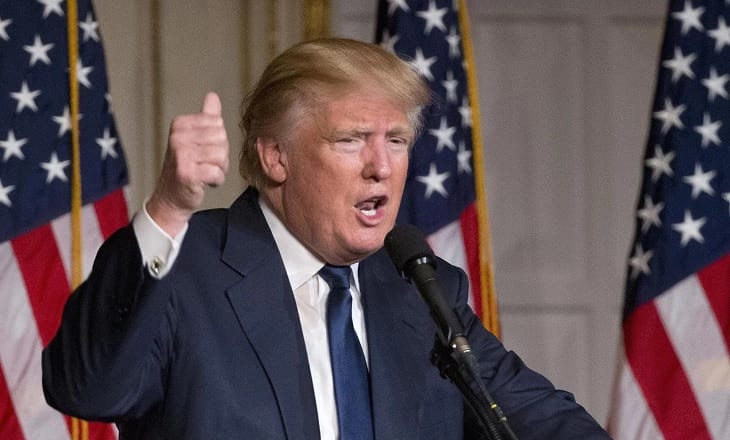We’re edging closer to the one-year anniversary of one of the most jaw dropping U.S. election results in recent history. Saying the words ‘President Donald Trump’ used to sound like a punchline to a joke, but this is the new normal that the world has had to adapt to in 2017. This includes the commodity and forex markets, which have already felt the effect of his off the cuff and provocative leadership, writes FXTM Senior Writer, Nikola Grozdanovic.

Nikola Grozdanovic, FXTM
When midnight struck on 8 November, 2016, pundits were faced with one of the biggest political upsets in modern times. As soon as the news broke, the Dow Jones fell by 800 points and the USD plummeted. But then, Trump delivered his unexpectedly grounded conciliatory speech and the U.S. dollar immediately stabilised, while the stock market surged with a triple-digit rally.
This reaction was a clear sign that Trump’s words carried a lot of weight. His infamous disdain for the North American Free Trade Agreement (NAFTA) turned forex traders and investors against the Canadian dollar and Mexican peso, both of which plunged on 9 November. When Trump signed his first executive order and withdrew the U.S. from the Trans-Pacific Partnership (TPP) on 23 January, the traditional safe-haven currency pair USDJPY had its best trading day of the year. In fact, the President’s first 100 days is littered with examples of the effect the so-called ‘Trump Trade’ has had on currency and commodity markets. On 31 January, the U.S. dollar went on a selling spree against major G10 currencies when the President labelled China a currency manipulator. Then for good measure, Peter Navarro, director of the White House National Trade Council, accused Germany of using a “grossly undervalued” euro as a way to “exploit” trading partners. The markets showed their disdain by selling off the dollar.
In April, when Trump ordered the air strike on Syria, oil prices surged, and gold –the investor’s go-to commodity during geopolitical shakeups – hit a five-month high.
Trump’s policies (and his rhetoric surrounding them) have also had major sway in the markets. Every time his healthcare bill hit the wall, the USD weakened. By the summer, the Trump Trade had all but lost its bite as it became apparent that the Washington establishment stood in the way of the President’s protectionist policy plans.
On a more positive note, his announcement of the “biggest tax reform in decades” brought out the dollar bulls in February, and then again on 27 September when the tax plan was laid out. The promise of $6 trillion in tax cuts has given hope to U.S.-based companies, and reignited interest in the greenback. However, this exuberance may not last long as he continues to pick a fight with North Korea’s painfully unstable Kim Jong Un. Before the tax plan was announced, the U.S. dollar index was experiencing its worst losing streak in 14 years amidst threats of war.
At the same time, many analysts rightly don’t give all the credit to Trump. While his plan to overhaul taxes has strengthened the dollar, the recent rally can also be attributed to the possibility of a more hawkish Federal Reserve chair replacing Janet Yellen, higher interest rates on the horizon, and strong growth coming out of U.S. manufacturing industries.
What we can be sure of, after nearly a year in the Trump era, is that the new U.S. President has brought the unexpected to the political table. Through his Tweets, scratchy rhetoric, anti-globalisation shakeups on trade deals, sabre rattling with foreign leaders, and legislative battles against the Washington establishment, two main narratives have emerged: a general lack of confidence in Donald Trump as Commander-in-Chief of a superpower, and an atmosphere of tense geopolitical uncertainty. His questionable leadership style has turned investors and FX traders against the U.S. dollar, despite the country’s healthy GDP and record highs for the stock market. Jittery markets have responded to the threat of war, by embracing gold – the biggest winner in the markets during times of fear and uncertainty. The yellow metal was trading below $1,130 per ounce by the end of 2016, while this year it has hit highs not seen since 2010, with some analysts predicting it will reach $1,400/oz. within the next 12 months.
How will ongoing tensions with North Korea continue to unravel? How will Trump’s policy plans continue to roll out (or will they roll out at all)? Will he be the most unpopular president since James Buchanan? These are just some of the questions that will most likely linger after we pass the one-year mark of the U.S. elections. No one can hang their hats on the outcomes but the answers, no matter how ambiguous, will certainly make for an interesting story in the markets.
For more information please visit FXTM at www.forextime.com.
Disclaimer: The content in this article comprises personal opinions and ideas and should not be construed as containing personal and/or other investment advice and/or an offer of and/or solicitation for any transactions in financial instruments and/or a guarantee and/or prediction of future performance. FXTM, its affiliates, agents, directors, officers or employees do not guarantee the accuracy, validity, timeliness or completeness of any information or data made available and assume no liability as to any loss arising from any investment based on the same.
Risk Warning: There is a high level of risk involved with trading leveraged products such as forex and CFDs. You should not risk more than you can afford to lose, it is possible that you may lose more than your initial investment. You should not trade unless you fully understand the true extent of your exposure to the risk of loss. When trading, you must always take into consideration your level of experience. If the risks involved seem unclear to you, please seek independent financial advice.
NOTES TO EDITORS
The FXTM brand provides international brokerage services and gives access to the global currency markets, offering trading in forex, precious metals, Share CFDs, ETF CFDs and CFDs on Commodity Futures. Trading is available via the MT4 and MT5 platforms with spreads starting from just 1.3 on Standard trading accounts and from 0.1 on ECN trading accounts. Bespoke trading support and services are provided based on each client’s needs and ambitions – from novices, to experienced traders and institutional investors. ForexTime Limited is regulated by the Cyprus Securities and Exchange Commission (CySEC), with license number 185/12, licensed by South Africa’s FSB with FSP number 46614, and registered with the UK FCA under reference number 600475. FT Global Limited is regulated by the International Financial Services Commission (IFSC) with license numbers IFSC/60/345/TS and IFSC/60/345/APM.
